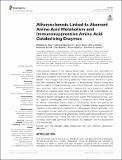Files in this item
Atherosclerosis linked to aberrant amino acid metabolism and immunosuppressive amino acid catabolizing enzymes
Item metadata
| dc.contributor.author | Zaric, Bozidarka L. | |
| dc.contributor.author | Radovanovic, Jelena N. | |
| dc.contributor.author | Gluvic, Zoran | |
| dc.contributor.author | Stewart, Alan J. | |
| dc.contributor.author | Essak, Magbubah | |
| dc.contributor.author | Motwalli, Olaa | |
| dc.contributor.author | Gojobori, Takashi | |
| dc.contributor.author | Isenovic, Esma R. | |
| dc.date.accessioned | 2020-09-28T14:30:11Z | |
| dc.date.available | 2020-09-28T14:30:11Z | |
| dc.date.issued | 2020-09-28 | |
| dc.identifier | 269785311 | |
| dc.identifier | 45fe0ccb-a30c-48df-97fa-6d8e5338deff | |
| dc.identifier | 85092508235 | |
| dc.identifier | 000579031100001 | |
| dc.identifier.citation | Zaric , B L , Radovanovic , J N , Gluvic , Z , Stewart , A J , Essak , M , Motwalli , O , Gojobori , T & Isenovic , E R 2020 , ' Atherosclerosis linked to aberrant amino acid metabolism and immunosuppressive amino acid catabolizing enzymes ' , Frontiers in Immunology , vol. 11 , 551758 . https://doi.org/10.3389/fimmu.2020.551758 | en |
| dc.identifier.issn | 1664-3224 | |
| dc.identifier.uri | https://hdl.handle.net/10023/20698 | |
| dc.description | This work is part of the collaboration between the Laboratory of Radiobiology and Molecular Genetics, Vinca Institute of Nuclear Sciences, University of Belgrade, Belgrade, Serbia, and King Abdullah University of Science and Technology (KAUST), Computational Bioscience Research Center (CBRC), Thuwal, Saudi Arabia. The research was funded by the Ministry of Education, Science and Technological Development of the Republic of Serbia and by the KAUST grant OSR#4129 (E.R.I I TG). T.G. was supported by the KAUST Base Research Funds BAS/1/1059-01-01, respectively, while M.E. was supported by the KAUST Office of Sponsored Research (OSR) grant no. FCC/1/1976-17-01. | en |
| dc.description.abstract | Cardiovascular disease is the leading global health concern and responsible for more deaths worldwide than any other type of disorder. Atherosclerosis is a chronic inflammatory disease in the arterial wall, which underpins several types of cardiovascular disease. It has emerged that a strong relationship exists between alterations in amino acid (AA) metabolism and the development of atherosclerosis. Recent studies have reported positive correlations between levels of branched-chain amino acids (BCAAs) such as leucine, valine, and isoleucine in plasma and the occurrence of metabolic disturbances. Elevated serum levels of BCAAs indicate a high cardiometabolic risk. Thus, BCAAs may also impact atherosclerosis prevention and offer a novel therapeutic strategy for specific individuals at risk of coronary events. The metabolism of AAs, such as L-arginine, homoarginine, and L-tryptophan, is recognized as a critical regulator of vascular homeostasis. Dietary intake of homoarginine, taurine, and glycine can improve atherosclerosis by endothelium remodeling. Available data also suggest that the regulation of AA metabolism by indoleamine 2,3-dioxygenase (IDO) and arginases (1 and 2) are mediated through various immunological signals and that immunosuppressive AA metabolizing enzymes are promising therapeutic targets against atherosclerosis. Further clinical studies and basic studies that make use of animal models are required. Here we review recent data examining links between AA metabolism and the development of atherosclerosis. | |
| dc.format.extent | 27 | |
| dc.format.extent | 2273966 | |
| dc.language.iso | eng | |
| dc.relation.ispartof | Frontiers in Immunology | en |
| dc.subject | Amino acids | en |
| dc.subject | Atherosclerosis | en |
| dc.subject | Metabolism | en |
| dc.subject | Branched-chain amino acids | en |
| dc.subject | Arginine | en |
| dc.subject | Tryptophan | en |
| dc.subject | QR180 Immunology | en |
| dc.subject | SDG 3 - Good Health and Well-being | en |
| dc.subject.lcc | QR180 | en |
| dc.title | Atherosclerosis linked to aberrant amino acid metabolism and immunosuppressive amino acid catabolizing enzymes | en |
| dc.type | Journal item | en |
| dc.contributor.institution | University of St Andrews. School of Medicine | en |
| dc.contributor.institution | University of St Andrews. Sir James Mackenzie Institute for Early Diagnosis | en |
| dc.contributor.institution | University of St Andrews. Institute of Behavioural and Neural Sciences | en |
| dc.contributor.institution | University of St Andrews. Biomedical Sciences Research Complex | en |
| dc.contributor.institution | University of St Andrews. Cellular Medicine Division | en |
| dc.identifier.doi | https://doi.org/10.3389/fimmu.2020.551758 | |
| dc.description.status | Peer reviewed | en |
This item appears in the following Collection(s)
Items in the St Andrews Research Repository are protected by copyright, with all rights reserved, unless otherwise indicated.

